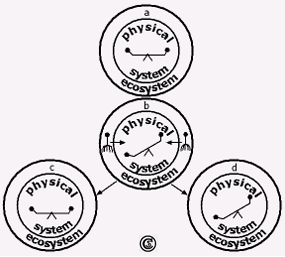Concept of Landscape Sensitivity
Assessments of landscape sensitivity are the basis for decision making about Watershed Management strategies (Beck et al. 2004; Tidemann 1996). What is meant by landscape sensitivity? The term landscape sensitivity is defined in diverse ways (Countryside Agency 2007; Thomas and Allison 1993).
Definition of Landscape Sensitivity
Here, landscape sensitivity is regarded as the potential for and the probable magnitude of change within a physical system in response to external effects and the ability of this system to resist the change (Thomas and Allison 1993).The external effects can be varied. They include natural as well as human induced phenomena (Thomas and Allison 1993). An example for the former may be a change in a climatologic parameter, e.g., an increasing temperature and a changed discharge level. Any hydrological system will adapt to this new level. Human induced phenomena can be summarised by the term human impact; i.e. the probable effects of human activity (whereas they use natural resources) on the landscape and the degree to which the system may be altered (Thomas and Allison 1993). Disturbances of the soil or water balance by agricultural activities are an example of the latter.
Climate and human activities are - to different extents - important driving forces for changes and development of landscapes and landforms worldwide. Thus, the sensitivity issue concerning both these changes is one of the most relevant ones (Thomas and Allison 1993).
Related terms to Landscape Sensitivity
The ability of the system faced with external interferences to withstand the change is often expressed by the term resilience. Often it is used as the antithetical term to sensitivity. A highly sensitive system possesses a low resilience and vice versa. Systems with low resilience are fragile. After disturbance these do not quickly return to their former equilibrium (see figure). Thus, ecologists employ sensitivity and fragility as synonyms. Although according to Thomas and Allison the term landscape sensitivity has a much broader scope than fragility; both terms are used here equivalently. The 'opposite' of both is landscape capacity. According to Tidemann (1996) this refers to such properties that determine the ability of a landscape to reproduce on a permanent basis. Although both terms are used in this way here, it has to be considered that sensitivity and capacity are not essentially interrelated in every landscape (Countryside Agency 2007).
Landscape Sensitivity can vary through space and time (Thomas and Allison 1993).
The physical systems considered in this module are watersheds, exemplified by the Gina River catchment. It is located in Eastern Africa, a semi-arid to sub-humid region which shows generally a high fragility. Hence, growing pressure on land and water resources shows more rapid effects than in temperate zones. Traditional resource management measures are no longer feasible today and traditional knowledge might get lost (Förch and Schütt 2004 a). The basis for a concept of sustainable management of natural resources is established by the assessment of landscape sensitivity. This is done in the Gina River catchment with a focus on soil erosion due to severe problems linked with this degradation process. Also water balance problems are addressed. For this, a detailed environmental analysis is necessary. This includes the recording of various factors controlling and reflecting the capacity of the landscape. Environmental analyses exemplified by the Gina River catchment are topic in the following.

Landscape sensitivity of different systems.
a Physical system in equilibrium
b Agricultural activities disturb the system
c Physical system showing a relatively low sensitivity to the external effect
d A high sensitive system that do not return to the former equilibrium.